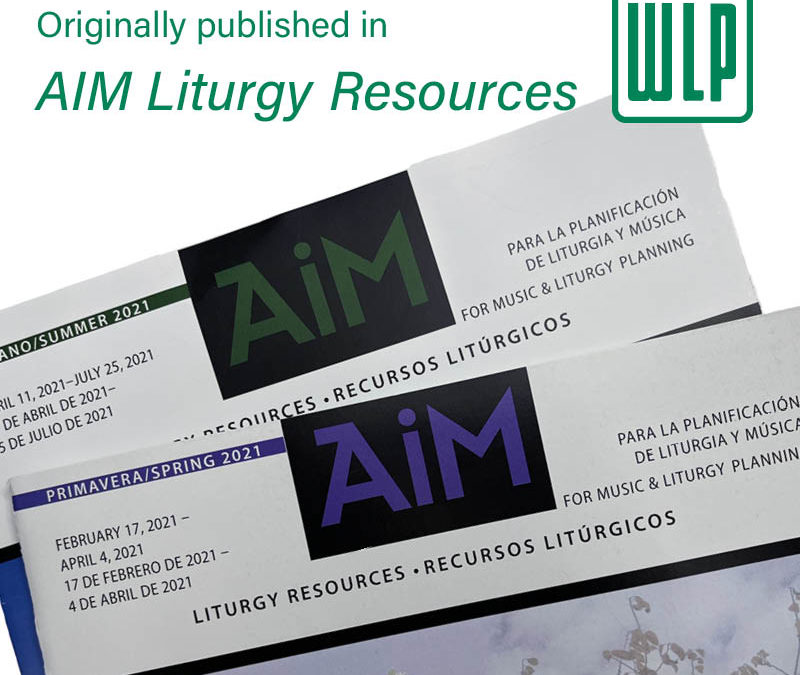This article was originally published in the Fall 2017 issue of AIM: Liturgy Resources.
One might wonder about the value or significance of repeating the same texts with little or no variation every week and in some cases, every day. After all, isn’t variety “the spice of life”? Yet, there are two important reasons why the repetition of the Ordinary texts is an asset for both promoting participation and forming an assembly into the one Body of Christ. In a very real way, these two goals are integrally connected with the spiritual development of those who so participate.
Acclaiming the Lord, Imploring Mercy
Singing these Ordinary texts has along and varied history in Christian worship. From the earliest days of the church’s celebration of the Eucharist until the most recent time, singing has been normative, particularly for Sundays. Historians believe that the first text, the Kyrie Eleison, appeared in the Antioch-Jerusalem liturgy as early as the fourth century, and became part of the Roman liturgy in the fifth century. Clerics, choirs, and congregations have variously sung this text as an acclamation or litany. Today this Ordinary text, included in the introductory rites, is usually sung by the Antioch congregation in combination with cantor, choir, or singing presider or deacon. The General Instruction of the Roman Missal (GIRM,2002) states that it follows the Act of Penitence, unless it has already been included. The Instruction continues: “Since it is a chant by which the faithful acclaim the Lord and implore his mercy, it is ordinarily done by all, that is, by the people and with the choir or cantor having a part in it” (#52). Notice that the text highlights two aspects of the chant: acclaiming the Lord and imploring God’s mercy.
The Gloria follows the Kyrie. It is considered a hymn, very ancient in its origins, and sometimes described as “the greater doxology.”However, it became a standard part of Sunday worship in the West much later than the Kyrie, around the eighth century. GIRM notes that it should be sung by the people but can include the assistance or embellishment of cantor or choir (#53). Its title, “Angelic Hymn,” is a reference to the song of the angels heard by the shepherds at the announcement of Christ’s birth (Luke 2:13–14).
The assembly sings the Sanctus (Holy, Holy) at the conclusion of the Preface prayer. The first of the Eucharistic acclamations, it is also sometimes referred to as the“Angelic Hymn.” This is because the first part is an adaptation of Isaiah 6:3. Early on, the Benedictus (“Blessed is he who comes in the name of the Lord”) was added. From its ancient origins, this acclamation was considered a song of the people. Later, around the eleventh century, the choir took over the singing of this Ordinary text. In the Roman rite, the reforms of the Second Vatican Council returned it to the entire congregation.
The Agnus Dei, or Lamb of God, is sung during the fraction rite just before the Communion rite. This practice of the people and the clergy singing during the time the bread was broken and the wine poured probably developed in the seventh century, but practice has varied.Today this litany includes three repetitions. The first two conclude with “Have mercy on us” and the last, “Grant us peace.”
Formative Power of the Texts
As constant elements in the liturgy, these four texts play a significant role in the prayer of the assembly. First of all, while Sacrosanctum Concilium (Constitution on the Sacred Liturgy) points out that useless repetitions should be eliminated in the liturgy (#34), these instances of repetition indicate that it is not judged useless or superfluous. While it is true that the acclamations in the Kyrie were abbreviated from nine to six, there is still significant repetition. The Kyrie, Sanctus, and Agnus Dei are included in each celebration of the Eucharist, as is the Gloria for Sundays outside of Advent or Lent. This specific type of repetition gets to the heart of the formative power of these texts.
The Kyrie, Gloria, Sanctus, and Agnus Dei serve as common threads woven throughout the liturgical year. As we pray them week by week, season by season, and year by year, these Ordinary texts become familiar points of contact and our common vocabulary for singing before God. When sung freely and with conviction, the assembly’s performance is a quintessential example of praying or singing “by heart,” that is, from the depths of our very being. This is not so much the case when these texts are recited (and more often come off sounding like a mumble or grunt). When we sing, our entire body is involved in breathing forth the song and allowing it to resound and reverberate from the depths of our entire bodies. Also, the four texts highlight an important aspect of our relationship with God. In the Kyrie, we pray the phrase “Have mercy” six times. In the Gloria and in the Agnus Dei we pray the phrase “Have mercy on us” twice in each text. Confronted with an awareness of God’s “glory,” proclaimed with great flourish in the Gloria and Sanctus, the appropriate posture of creature to Creator is one of humility. These texts enable us to speak our need for God’s mercy and acknowledge God as the merciful one. These profound Christian attitudes of praise and thanksgiving for God’s glory and merciful love are fundamental to the life of a Christian and a just or right relationship with God.
The Power of Performative Language
How does this actually happen in the liturgy? Performative language theory explains that language has a power that is enhanced when combined with elements such as pitch, rhythm, and melodic contour. In other words, language combined with music has the potential to accomplish something in the actual performance of singing. In the case of ritual activity, singing is not meant to provide information, but rather allows participation in a known and repeatable situation. The singing of these Ordinary texts situates the assembly in a sonic environment marked by sung attitudes of praise and an acknowledgment of God’s mercy and a profound need for that mercy. As individuals and as a group, the assembly is drawn into the activity and participates in the music making. Furthermore, the situation is repeatable. This “speaking” of attitudes of praise and the need for God’s mercy occurs in the singing. As a result, the assembly (and each individual within it) are gradually, overtime and many repetitions, formed or shaped in these specific Christian attitudes.Something is accomplished on multiple levels: God is praised for divine glory and mercy, the truth of God’s mercy is manifested, a community is constituted, and individuals are formed in the Christian attitudes that are expressed in the sung texts of the Ordinary.
Also, while the cycle of liturgical seasons allows for variety in hymns and psalms to be sung, the Ordinary texts have a reverse kind of variety that is just as significant. Although the texts are constant, the musical settings of those texts need to be carefully selected to reflect the spirit of each season as well as the principles of progressive solemnity. So, for example, it is helpful when there is a clear difference between the music of the Ordinary in Lent and the Fifty Days of Easter (to cite the obvious). Forming the assembly in the appropriate spirit of each liturgical season is another important benefit of choosing certain musical settings for certain seasons and, yes, repeating them each year.
Of course, liturgical singing, even when done well, does not guarantee conversion or metanoia. However, as Christians we believe that the Spirit is present in the assembly’s prayer, and if members are open to the possibility of change, transformation can occur. One of the important aspects of our repeated singing of these Ordinary texts is that they have the power to awaken specific Christian dispositions that open up existence to a wider reality. That awakening can actually be promoted through repetition. As Church music professor Don Saliers reminds us, ritual music has the potential to form—over time—the affections (affectivity) and imagination of the assembly.
In the case of these Ordinary texts, this means assisting in the formation of Christians, who can then spontaneously break into extraordinary song in praise of God’s merciful love.

Judith M. Kubicki, CSSF is the Associate Professor of Theology at Fordham University in New York City. She is a Felician Franciscan Sister from Buffalo, New York, and serves as a liturgical music reviewer for Worship magazine. Her book The Song of the Singing Assembly is available at giamusic.com.


Recent Comments